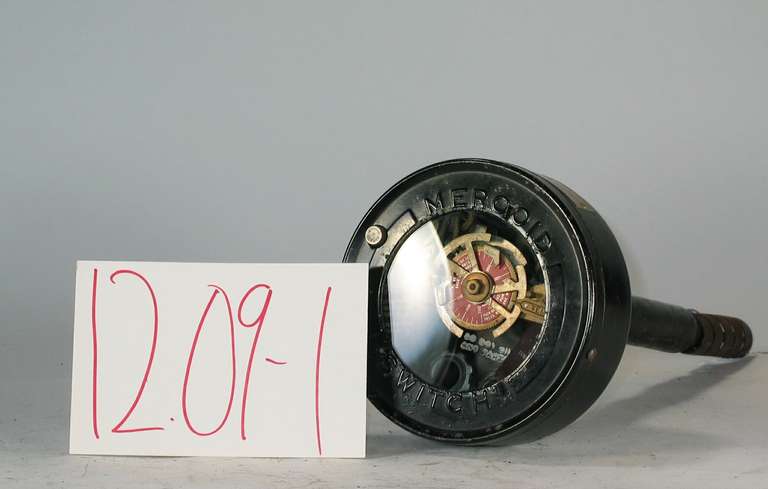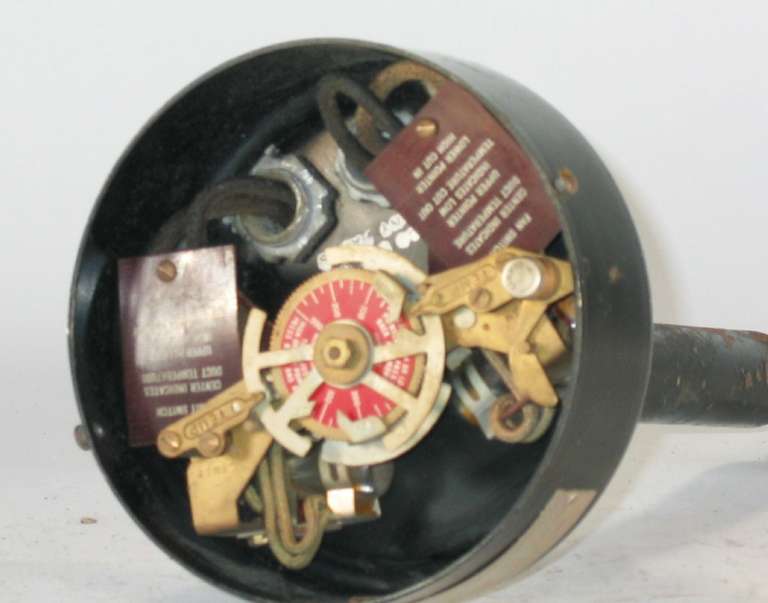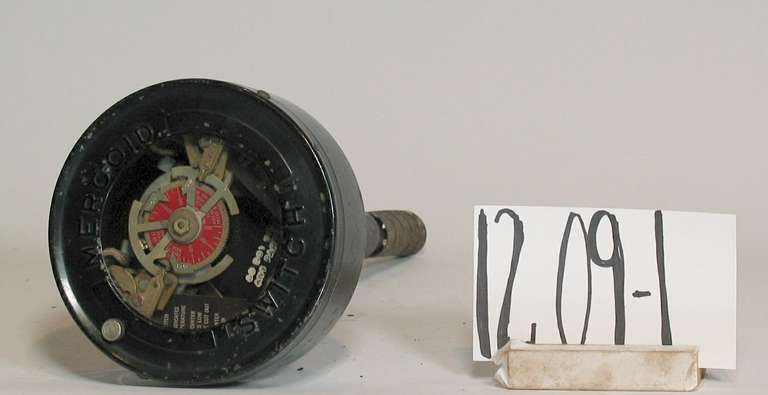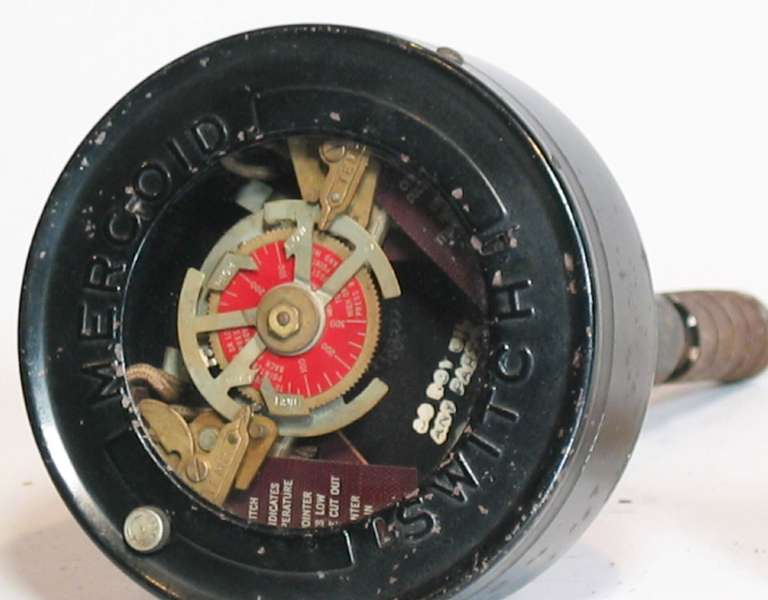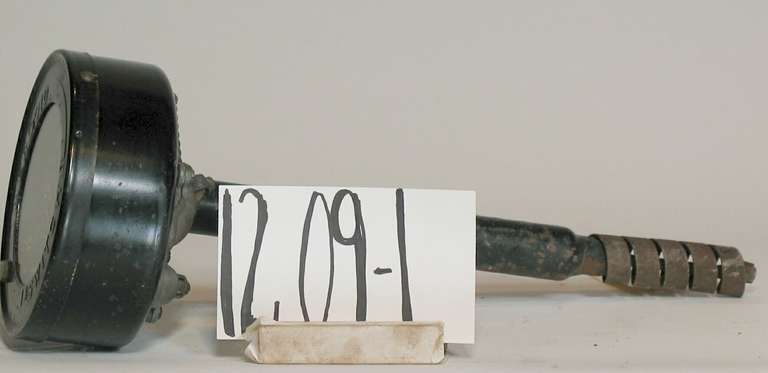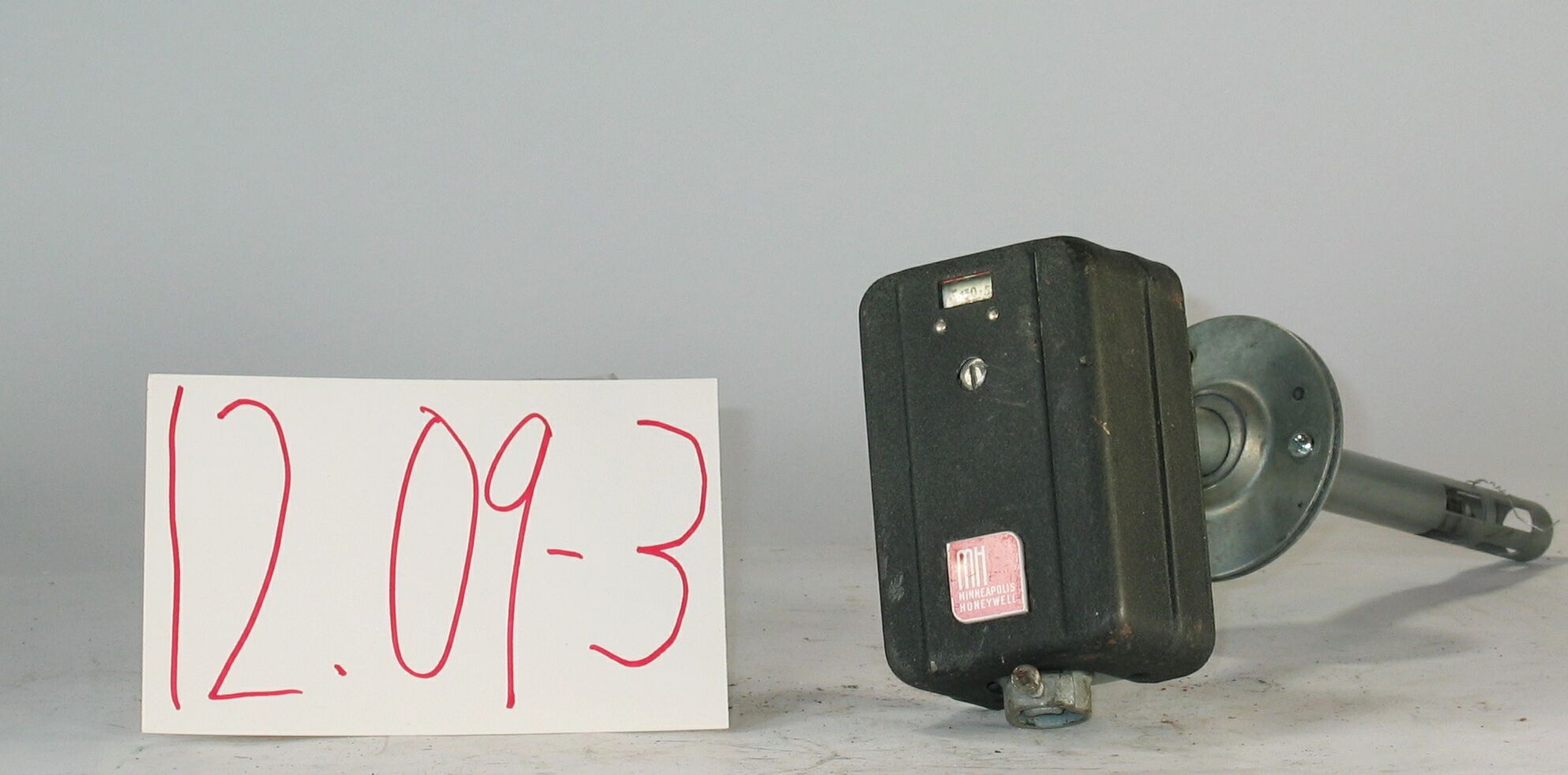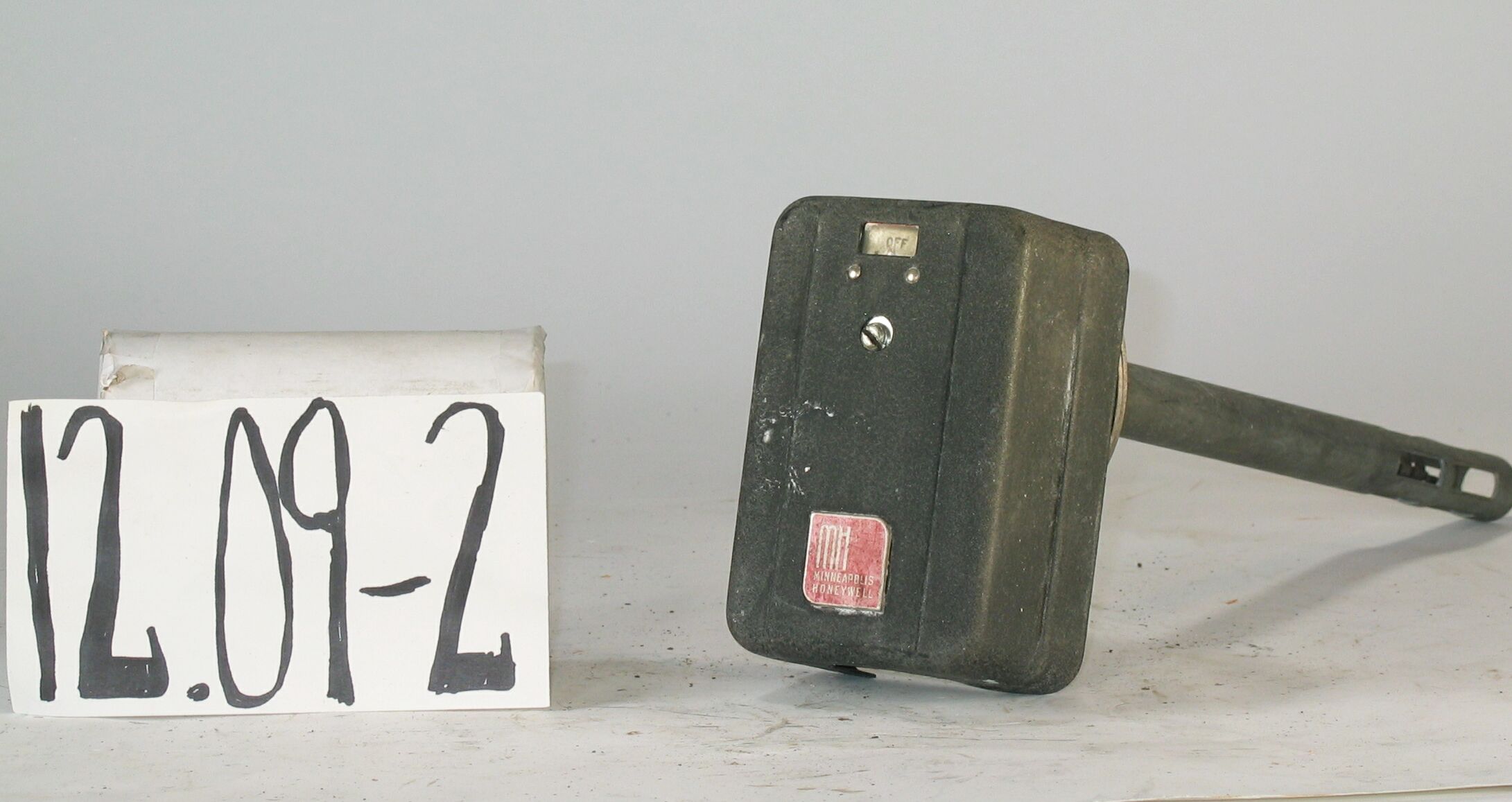12.09-1: Mercoid 1938 Adjustable Temperature Control
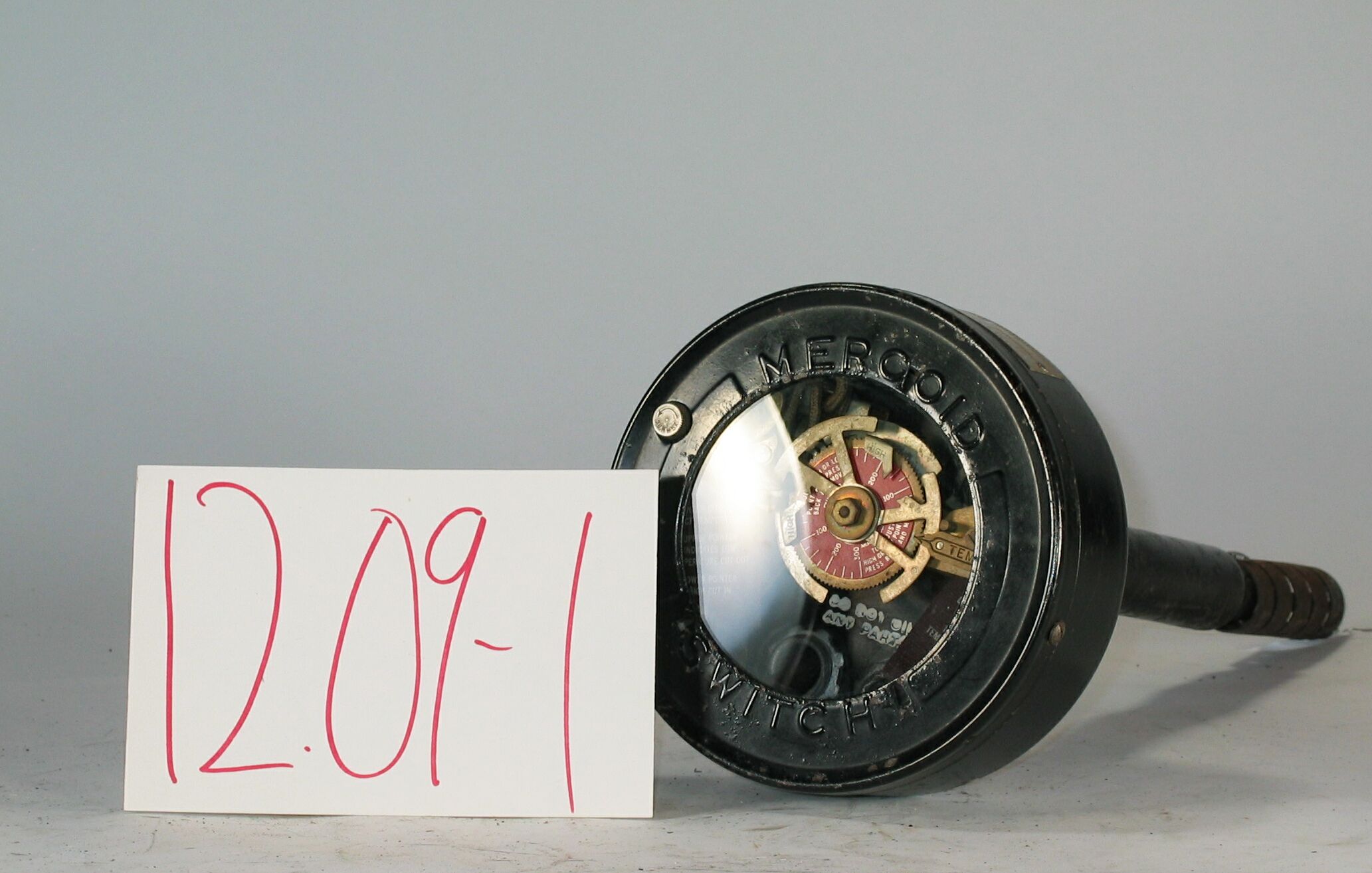
| HHCC Accession No. 2006.113 | HHCC Classification Code: 12.09-1 |
|---|
Description:
A mid 20th century, state-of-the-art, double function, adjustable temperature control for home ‘winter air conditioner’. Used for automatically shutting down the system to prevent over heating, as well as to start and stop the furnace fan at air temperatures that would help ensure draft free comfort; equipped with helical bimetal heat sensor, twin, tilting mercury bulbs, mechanical brass linkage and manual fan on-off switch, fan and limit control, Type M80, Mercoid, 1938
Group:
12.09 Pressure Atomizing Oil Burner Equipment and Systems ‘ Automatic Temperature Controls
Make:
Mercoid
Manufacturer:
Mercoid Corporation, Chicago Ill.
Model:
Type M80
Serial No.:
M239302
Size:
6 in rd x 16 in long
Weight:
4 lbs.
Circa:
1938
Rating:
Exhibit, education, and research quality, illustrating the engineering design of mid 20th century dual function automatic air temperature controls for ‘winter air conditioners’ in Canada
Patent Date/Number:
1991350 [1935]; 1834288 [1931]; 1949915 [1934]; 2018310 [1935]
Provenance:
From York County (York Region) Ontario, once a rich agricultural hinterlands, attracting early settlement in the last years of the 18th century. Located on the north slopes of the Oak Ridges Moraine, within 20 miles of Toronto, the County would also attract early ex-urban development, to be come a wealthy market place for the emerging household and consumer technologies of the early and mid 20th century.
This artifact was discovered in the 1950’s in the used stock of T. H. Oliver, Refrigeration and Electric Sales and Service, Aurora, Ontario, an early worker in the field of agricultural, industrial and consumer technology.
It was used on a ‘South Wind’ winter air conditioner by Howard Furnace and Foundries installed at 68 spruce Street Aurora in 1940
Type and Design:
Equipped with helical bimetal heat sensor, Extended 13 in. temperature probe twin, tilting mercury bulbs and Manual fan on-off switch, Complex system of interconnecting mechanical linkages fabricated in brass sheet stock and secured with brass machine screws Temperature calibration dial in red and gold Operating, adjustment instruction etched in gold on twin fibreboard insets Glass bezel
Construction:
Material:
Special Features:
Temperature calibration dial in red and gold Operating, adjustment instruction etched in gold on twin fibreboard insets Glass bezel Original wiring stubs with steel sheathed cable [BX] and heavy duty L box connectors
Accessories:
Capacities:
Performance Characteristics:
Operation:
Control and Regulation:
Targeted Market Segment:
Consumer Acceptance:
Merchandising:
Market Price:
Technological Significance:
A mid 20th century, dual function temperature controller, exquisitely crafted using the materials and engineering know-how of the immediate pre W.W.II years Designed for a new, emerging, yet still elite market for winter comfort, the ‘winter air conditioner’. Mercoid went to great lengths to show off its new, elite, automatic, dual temperature control technology, beautifully crafting with showy glass front panel and mechanical operating mechanism crafted in brass. It was to be a prestigious controller for the homeowner anxious, and able to afford the best that the HVACR industry of the times could provide, anxious too to be able to show it off for what it was, a piece of new technology ahead of its times.
Air circulation was a matter of engineering concern, ensuring draft free comfort for homeowners not at all used to constantly moving air in the home. The key was the temperature at which the winter air conditioner’s fan would start circulating the pre-warmed air, and at what air temperature would the fan stop The manual fan switch was an important sales feature, too, allowing the homeowner to manually turn the system on in the summer time to circulate filtered air throughout the home [For an account of recommended industry practices of the time operation See, ‘Winter Air Heating and Winter Air conditioning’, John Norris McGraw-Hill 1950. It would be a period characterised by much research in the field of human comfort. its necessary and sufficient conditions and the means of creating it in Canada’s climate of weather extremes. Warm air heating research would become a legitimate topic for university, as well as industrial research with technical papers and how-to-do-it manuals to follow. Characteristic of the period and the emerging market for winter comfort was the creation of the National Warm Air Heating and Air Conditioning Association of Canada [forerunner of the Heating, Refrigeration and Air Conditioning Institute of Canada]. Their extensive set of engineering manuals produced through the 1950’and 60’s would be the standards of the field
Industrial Significance:
The control of air movement in forced air, residential systems, to ensure safe comfortable conditions was and continues to be a challenge. With fixed, non modulating, forced air heating equipment, which characterizes the residential field, the control of air movement through the furnace and the home was accomplished with on-off switching of the fan motor. The goal is to ensure the furnace doesn’t over heat, as a result of low air quantity, but at the same time, the householder is not subject to the movement of unheated air through the house causing drafts.
For the purpose of initially balancing the system, variable speed fan pulley drives were widely used to adjust fan speeds [see collection Group 12.11], until electrically variable speed, digital motor control technology became available.
Two speed motors with double windings were also used in the 1950’ through 80’s, with two step controller to reduce air flow at low during start up and shut down.
Socio-economic Significance:
With the introduction by the HVACR industry of forced air heating, a world change had taken place. It brought with it significant new market potential, for the replacement of a nation full of gravity, central, warm air heating systems, to be replaced with a new generation of modern automatic, central home heating equipment, dubbed the winter air conditioner. Public expectations were high, seeded in no small way by the marketing of the industry. With the development of the forced air furnace ‘the winter air conditioner’ came many new possibilities for winter comfort, automatic combustion control for solid and liquid fuels [coal and oil], automatic room temperature control, air distribution [well beyond that possible with natural convection], constant air circulation. air filtration, as well as automatic humidification . These features would be promoted by the warm air sector of the industry, as a competitive edge, over the ‘hot water heating systems [hydronic systems] of the times, once considered the preferred type of central heating for all that could afford it. During the 1940’s and 50’s the Howard Furnace Co of Toronto would be an acknowledged leader in the field of winter air conditioning equipment for the Canadian market, see reference. There promotion would read ‘Enjoy filtered, humidified, gently moving air throughout every part of your home’, ‘Have even temperature maintained in all rooms with lowest possible fuel costs and little attention”. This was surely new world experience for Canadians in the middle years of the 20th century
Socio-cultural Significance:
Donor:
G. Leslie Oliver, The T. H. Oliver HVACR Collection
HHCC Storage Location:
Tracking:
Bibliographic References:
Howard South-Wind, Air Conditioning and heating Unit, Howard Furnace Co. Toronto, sale brochure, undated, circa 1940 ‘Winter Air Heating and Winter Air conditioning’, John Norris McGraw-Hill 1950, Chapter 9, Humidity and the properties of Air.
Notes:
Related Reports:
CMX02, Item H 15
